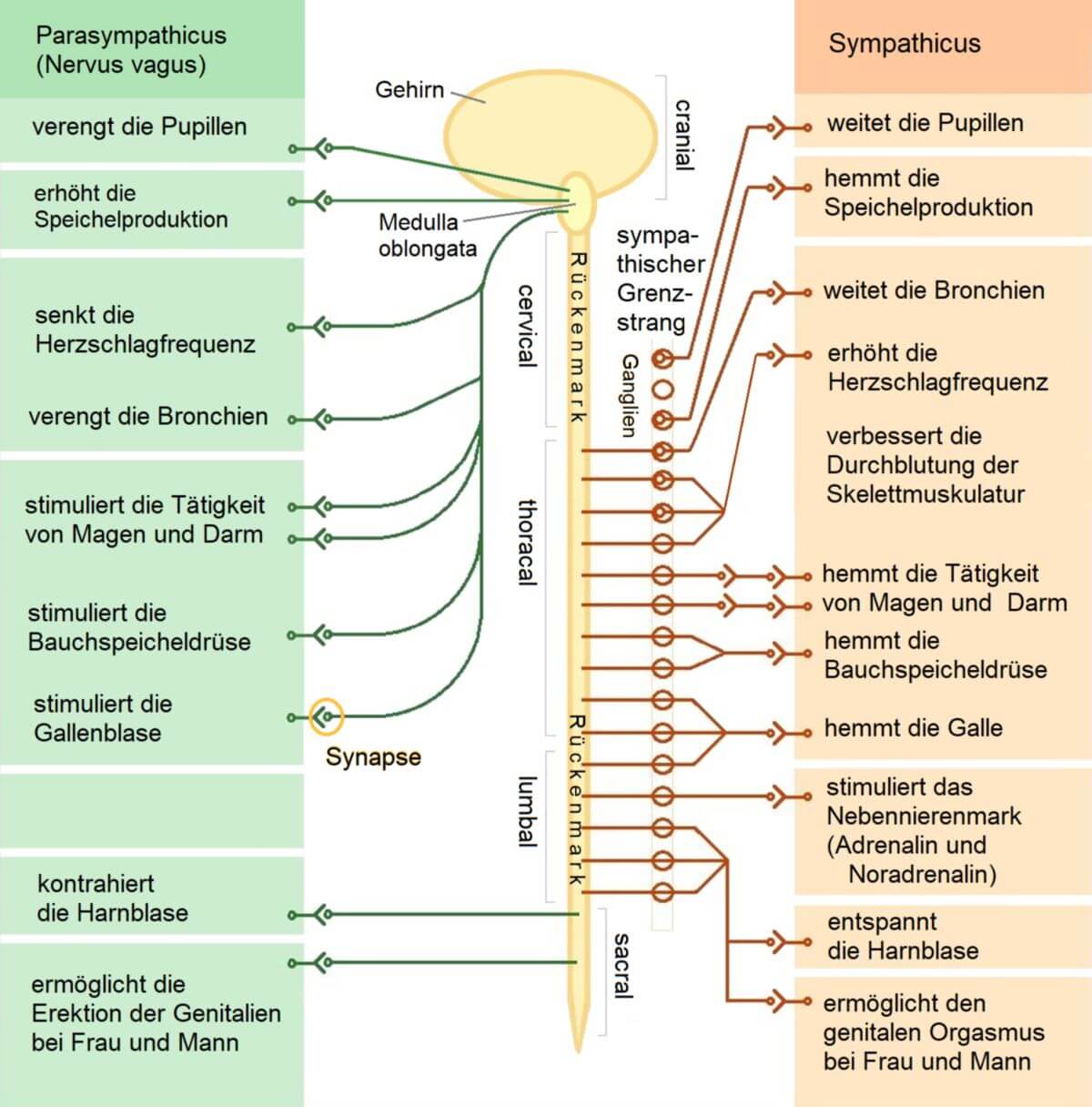Parasympathikus
von griechisch: para - gegen; sympathikos - mitleidend
Synonyme: Pars parasympathica, Pars parasympathetica
Englisch: parasympathetic nervous system
Definition
Der Parasympathikus ist als Teil des vegetativen Nervensystems Gegenspieler (Antagonist) des Sympathikus. Durch ihn werden vorwiegend Körperfunktionen innerviert, die der Regeneration des Organismus und dem Aufbau von Energiereserven (trophotrop) dienen. Das innere Gleichgewicht (Homöostase) des Organismus wird auch unter seinem Einfluss wieder hergestellt.
Anatomie
Die parasympathischen Kerngebiete liegen im Bereich des Hirnstammes und des Sakralmarkes. Die Hirnnerven III (Nervus oculomotorius), VII (Nervus facialis), IX (Nervus glossopharyngeus) und besonders X (Nervus vagus) enthalten parasympathische Fasern, die die Muskulatur und Drüsen des Kopf-Hals-Bereiches innervieren. Der Hirnnerv V (Nervus trigeminus) führt ebenfalls streckenweise parasympathische Fasern, die jedoch originär vom Nervus facialis stammen. Die inneren Organe des Thorax und teilweise des Abdomens werden vom Nervus vagus erreicht.
Daneben treten aus den sakralen Rückenmarkssegmenten S1 bis S3 parasympathische Nervi splanchnici pelvici (Nn. erigentes) aus, die den aboralen Bereich des Dickdarms (etwa ab der linken Colonflexur) und die Strukturen des kleinen Beckens (u.a. die Harnblase) innervieren.
- siehe auch: Cannon-Böhm-Punkt
Physiologie
Die parasympathischen Nerven verwenden Acetylcholin (ACh) sowohl an der 1. Synapse im Ganglion, als auch an der 2. Synapse am Zielorgan als Neurotransmitter. Dadurch unterscheiden sie sich vom Sympathikus, dessen Neurotransmitter an der 2. Synapse Noradrenalin ist.
Acetylcholin wirkt in beiden Systemen an der 1. Synapse, also bei der Umschaltung vom 1. auf das 2. Neuron, über nikotinerge Rezeptoren (nAChR). An der 2. Synapse, bei der Umschaltung auf das Zielorgan, findet man beim Parasympathikus Acetylcholin und muskarinerge Rezeptoren (mAChR), während beim Sympathikus Noradrenalin und Adrenozeptoren vorkommen.
Neben Acetylcholin spielen im parasympathischen Nervensysten die Kotransmitter Stickstoffmonoxid (NO) und vasoaktives intestinales Peptid (VIP) eine Rolle bei der Erregungsübertragung.
Organotrope Wirkungen des Parasympathikus
- Herz
- negativ chronotrop
- negativ dromotrop
- Blutgefäße
- direkte Wirkung fraglich, im Genitalbereich vasodilatorisch
- indirekte Vasodilatation durch Hemmung des tonisierenden Sympathikus, hier gibt es jedoch organspezifische Unterschiede
- Bronchien
- konstriktorisch
- vermehrte Schleimsekretion
- Gastrointestinaltrakt
- vermehrte Drüsensekretion
- verstärkte Peristaltik
- Harnblase
- Kontraktion des Musculus detrusor vesicae
- Erschlaffung des Sphinkter
- Uterus
- Kontraktion
- Auge
- Kontraktion des Musculus sphincter pupillae mit folgender Miosis
- Kontraktion des Musculus ciliaris mit verstärkter Akkommodation
- Speicheldrüsen
- vermehrte Speichelproduktion
Pharmakologie
- Medikamente, die den Parasympathikus verstärken, nennt man Parasympathikomimetika. Dabei unterscheidet man direkte Mimetika (Beispiele: Acetylcholin, Pilocarpin, Muscarin, Arecolin) mit Wirkungen an Acetylcholin-Rezeptoren und indirekte Mimetika, die die Acetylcholinesterase hemmen (Beispiele: Physostigmin, Neostigmin, Pyridostigmin).
- Medikamente, die den Parasympathikus hemmen, nennt man Parasympathikolytika (Beispiele: Atropin, Scopolamin, Tropicamid und deren Derivate)
siehe auch: Sympathikus, Vegetatives Nervensystem
Weblinks
um diese Funktion zu nutzen.











